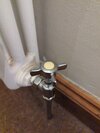I have a house full of traditional style radiators but valves on either side are normal valves (not TRv). How do I know which is inlet and which is lockshield? Should I assume the inlet is always the same side as the bleed valve? Thanks in advance..
You are using an out of date browser. It may not display this or other websites correctly.
You should upgrade or use an alternative browser.
You should upgrade or use an alternative browser.
Both rad valves look the same
- Thread starter milo333
- Start date
-
- Tags
- radiators traditional valves
If you really need to know which valve is flow when heating system is cold turn it on and note which valve on each rad gets warm first.
I very much doubt they will all be on same side!
I very much doubt they will all be on same side!
Neither are the lockshield. A lockshield valve is one that is set and then suppose to be tamper resistant and left alone, hence why they usually have a plain white cap on them or are an allen key under a nut. It's a bit of a misnomer though when it comes to most rad valves, a proper lockshield is a valve that has a cover around the valve stem and usually needs a key to operate.

As suggested, When the system is cold, turn on the CH and see which one heats up first, that's the flow into the rad.
As suggested, When the system is cold, turn on the CH and see which one heats up first, that's the flow into the rad.
Thanks folks that's a great help. So, even though the outlets aren't lockshield valves, once I identify which are outlets, should I try to balance them so they don't take too much hot from the rads further away from the boiler (like the typical balancing routine)? It all seems a bit loosey-goosey having all the valves the same type and it seems some radiators are definitely losing out!
You can use either to balance the rad. When balancing you are simply throttling the rad to slow down the flow in and through it, so more flow is directed towards the others for a more even and balanced CH warm up. That can be achieved by throttling either valve.
Though if you have anyone that may then play with the valves once set, then ideally you want to remove the head from it to make it tamper resistant.
Though if you have anyone that may then play with the valves once set, then ideally you want to remove the head from it to make it tamper resistant.
This problem always occurs with towel rails! They often come with 2 manual valves and different members of the household try and turn rail on by operating either and/or both valves... Usually ends up with them both fully open, rail gets very hot and one or more other rads are robbed of flow!
Best thing to do is close one valve on all rads with other fully open, put CH on, open the valve you closed (on each rad) and feel tails to see which one gets warm first to determine flow side, then quickly close and do same with next rad and so on.
Then make a list of all rads, noting flow side for each.
Close all the return valves and open all the flow valves.
Then go back round and slightly open each determined return valve and wait a few mins until you feel heat coming in to flow side, do same for each other rad.
Give it 10 mins and go back and see which rads have stalled!
Open returns on these until you again feel heat flowing through.
Repeat after 10 mins if necessary, and so on until all rads are hot as you'd expect.
Finally, go to each rad and count how many turns it takes to close the return valves (down to a quarter turn). Then open it back up same number of. 25 turns.
Add these number of turns to your rad list and keep it in a safe place for future reference!
Best thing to do is close one valve on all rads with other fully open, put CH on, open the valve you closed (on each rad) and feel tails to see which one gets warm first to determine flow side, then quickly close and do same with next rad and so on.
Then make a list of all rads, noting flow side for each.
Close all the return valves and open all the flow valves.
Then go back round and slightly open each determined return valve and wait a few mins until you feel heat coming in to flow side, do same for each other rad.
Give it 10 mins and go back and see which rads have stalled!
Open returns on these until you again feel heat flowing through.
Repeat after 10 mins if necessary, and so on until all rads are hot as you'd expect.
Finally, go to each rad and count how many turns it takes to close the return valves (down to a quarter turn). Then open it back up same number of. 25 turns.
Add these number of turns to your rad list and keep it in a safe place for future reference!



